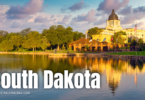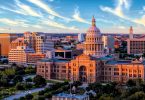Boise is the capital of the state of Idaho and is the most populous city in that state. It is also the county seat of Ada County and is located along the Boise River. It has a population of just over two hundred thousand people, which makes it the ninety-ninth most populous city in the United States.
It is part of the Boise-Nampa metropolitan area, which is also referred to as the Treasure Valley, and that area includes five counties, making it the most populous metropolitan area in Idaho. The three largest cities in the state are included in this metropolitan area, which is Boise, Nampa, and Meridian.
While the area that is now Boise was occupied by Native Americans for thousands of years, little is known of the pre-European history of the area. One of the early European explorations to the area was that of Captain B.L.E. Bonneville, who was a leader in the U.S. Army. As his exploration party going west went over some extremely rough and dry terrain, they reached a point overlooking the Boise River Valley. That place is now called Bonneville Point and is located along the Oregon Trail, which goes through Boise. As the story goes, once the exploration party reached the overlook, their French guide yelled “Les Bois!” This means “the woods” in French, and the exclamation became the name of the new village that soon settled there.
It would make sense that the name Boise comes from the French. Even before the United States began exploring the area, French trappers (always to be relied upon to be among the enterprising first in any North American area prior to the arrival of others) were recognizing the Boise River as a landmark in that part of the continent. Because the river is in a desert area, seeing it lined with verdant trees was remarkable, and the trappers soon referred to the river as La Riviere Boise,” meaning, “The Wooded River.”
By the time the U.S. Army established Fort Boise in the area, that place had been called Boise for a long time. The original fort was about forty miles west of where the city of Boise sits today, and closer to the border with Oregon. The fort was built in the 1830s but abandoned two decades later. However, it was re-established during the Civil War in 1863 due to massacres of Oregon Trail travelers by Native Americans.
The fort soon became a town, thanks to prosperous silver mines in the area. At the time, Idaho City was the largest city in the northwest part of North America. However, Boise acted as its staging area, and people flocked to it, and it was incorporated as a city in 1863. The capital of Idaho at the time was Lewiston. Also, Idaho was part of the greater Northwest Territory at the time, which was larger than Texas. However, once Montana Territory was carved out of the Northwest Territory, the capital of Idaho was moved to Boise.
Since then, Boise has become a center for the arts in the Northwest. Purveyors of jazz, indie music, and theater flock there. The Gene Harris Jazz Festival is held there every spring. There are also several local theater groups headquartered there, such as the Idaho Shakespeare Festival. Treefort Music Fest is held there in late March, which is a showcase for emerging bands, as well as other artists of most varieties. It used to be considered a strange little music festival, but is now a full-fledged and respected community event that is looked forward to each year by local residents. There is even a puppet theater in Boise that is well known in the United States called the HomeGrown Theatre. Plus, national and regional acts in music, comedy, and film screenings are held throughout the year at the renovated Egyptian Theater there.
When it comes to museums, Boise is also on point. It is home to the Boise Art Museum, the Basque Museum and Cultural Center, the Idaho Historical Museum, the Boise WaterShed Museum, the Idaho Black History Museum, and the Discovery Center of Idaho. An art museum gallery stroll is held the first Thursday of each month in the business district of the city.
Boise celebrated its sesquicentennial in 2013, which was called the Boise 150. This commemorative event was headed up by the Boise Department of Arts and History. The Department built the commemoration around the themes of enterprise, community, and environment. During that year, the Department of Arts and History occupied a storefront on Main Street and called it the Boise 150 Headquarters (aka the Sesqui-Shop). This space was used as a store, a place for exhibiting local art, and an event venue.
During the celebrations, local merchants produced authentic-looking reproductions of historic Boise goods and sold them at the Boise 150 Headquarters. Events for the celebration included Sesqui-Speaks, Walk 150, Thinking 150, Re-Art Children’s Program, and the Anniversary Weekend. There was also a Share Your Story program that included a commemorative book produced by local writers, and a commemorative CD of local musicians. The Department of Arts and History also gave a Legacy Grant to the Shoshone-Bannock Culture Committee during the celebrations.
Though it began as a rough fort in the middle of nowhere, Boise is now a prime place for arts and culture. A 2012 study by the Americans for the Arts group (which includes both public and private art projects) determined that the arts are a $48 million dollar a year industry in Boise. The study also accounted for 1600 jobs in the arts in Boise and revealed that the arts industry produced about four and a half million dollars a year in revenue to the local and state government. This is pretty impressive for a mountain town in a state that most Americans usually think of as having no tourist attractions except potatoes.
Boise has humble beginnings but is a thriving artistic hub of a city today. Those in Idaho are rightfully proud of it.





